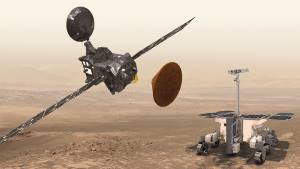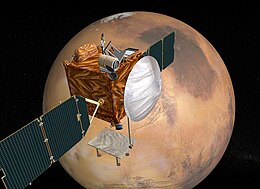
The planet Mars has been explored remotely by spacecraft. Probes sent from Earth, beginning in the late 20th century, have yielded a large increase in knowledge about the Martian system, focused primarily on understanding its geology and habitability potential. Engineering interplanetary journeys is complicated and the exploration of Mars has experienced a high failure rate, especially the early attempts. Roughly sixty percent of all spacecraft destined for Mars failed before completing their missions and some failed before their observations could begin. Some missions have met with unexpected success, such as the twin Mars Exploration Rovers, Spirit and Opportunity which operated for years beyond their specification.

Mars Reconnaissance Orbiter (MRO) is a spacecraft designed to search for the existence of water on Mars, as part of NASA's Mars Exploration Program. It was launched from Cape Canaveral on August 12, 2005, at 11:43 UTC and reached Mars on March 10, 2006, at 21:24 UTC. In November 2006, after six months of aerobraking, it entered its final science orbit and began its primary science phase.

ExoMars is an astrobiology programme of the European Space Agency (ESA).

The following outline is provided as an overview of and topical guide to space exploration.

The ExoMars Trace Gas Orbiter is a collaborative project between the European Space Agency (ESA) and the Russian Roscosmos agency that sent an atmospheric research orbiter and the Schiaparelli demonstration lander to Mars in 2016 as part of the European-led ExoMars programme.

MAVEN is a NASA spacecraft orbiting Mars to study the loss of its atmospheric gases to space, providing insight into the history of the planet's climate and water. The spacecraft name is an acronym for "Mars Atmosphere and Volatile Evolution" and also a word that means "a person who has special knowledge or experience; an expert". MAVEN was launched on an Atlas V rocket from Cape Canaveral Air Force Station, Florida, on 18 November 2013 UTC and went into orbit around Mars on 22 September 2014 UTC. The mission is the first by NASA to study the Mars atmosphere. The probe is analyzing the planet's upper atmosphere and ionosphere to examine how and at what rate the solar wind is stripping away volatile compounds.

The Mars Exploration Joint Initiative (MEJI) is an agreement signed between United States' space agency, NASA, and Europe's space agency, ESA to join resources and expertise in order to continue the exploration of the planet Mars. The agreement was signed in Washington D.C. in October 2009, between NASA administrator Charles Bolden and ESA director-general Jean-Jacques Dordain.
The beacon mode service is a Consultative Committee for Space Data Systems (CCSDS) telecommunications service aimed at spacecraft which are not communicated with via NASA's Deep Space Network. It is primarily designed to relay a spacecraft's "health" information, and secondarily its telecommunications status, using a simple signal that can be detected with a moderately-sized antenna. Beacon mode also enables spacecraft to communicate with one another on a daily basis, allowing for one spacecraft to act as a data proxy for another.

Electra, formally called the Electra Proximity Link Payload, is a telecommunications package that acts as a communications relay and navigation aid for Mars spacecraft and rovers. The use of such a relay increases the amount of data that can be returned by two to three orders of magnitude.

The Laser Communications Relay Demonstration (LCRD) is a NASA mission that will test laser communication in space for extremely long distances, between Earth and geosynchronous orbit.

Optical Payload for Lasercomm Science (OPALS) is a spacecraft communication instrument developed at the Jet Propulsion Laboratory that was tested on the International Space Station (ISS) from 18 April 2014 to 17 July 2014 to demonstrate the technology for laser communications systems between spacecraft and ground stations.

Phobos And Deimos & Mars Environment (PADME) is a low-cost NASA Mars orbiter mission concept that would address longstanding unknowns about Mars' two moons Phobos and Deimos and their environment.

Laser communication in space is the use of free-space optical communication in outer space. Communication may be fully in space or in a ground-to-satellite or satellite-to-ground application. The main advantage of using laser communications over radio waves is increased bandwidth, enabling the transfer of more data in less time.

The Next Mars Orbiter is a proposed NASA Mars communications satellite with high-resolution imaging payload and two solar-electric ion thrusters.

Mars Cube One was a Mars flyby mission launched on 5 May 2018 alongside NASA's InSight Mars lander. It consisted of two nanospacecraft, MarCO-A and MarCO-B, that provided real-time communications to Earth for InSight during its entry, descent, and landing (EDL) on 26 November 2018 - when InSight was out of line of sight from the Earth. Both spacecraft were 6U CubeSats designed to test miniaturized communications and navigation technologies. These were the first CubeSats to operate beyond Earth orbit, and aside from telecommunications they also tested CubeSats' endurance in deep space. On 5 February 2019, NASA reported that both the CubeSats had gone silent by 5 January 2019, and are unlikely to be heard from again. In August 2019, the CubeSats were honored for their role in the successful landing of the InSight lander on Mars.

Psyche is a planned orbiter mission to explore the origin of planetary cores by studying the metallic asteroid of the same name. Lindy Elkins-Tanton of Arizona State University is the principal investigator who proposed this mission for NASA's Discovery Program. NASA's Jet Propulsion Laboratory (JPL) will manage the project.

Schiaparelli EDM was a failed Entry, Descent, and Landing Demonstrator Module (EDM) of the ExoMars programme—a joint mission of the European Space Agency (ESA) and the Russian Space Agency Roscosmos. It was built in Italy and was intended to test technology for future soft landings on the surface of Mars. It also had a limited but focused science payload that would have measured atmospheric electricity on Mars and local meteorological conditions.

LADEE's Lunar Laser Communication Demonstration (LLCD) was a payload on NASA's Lunar Atmosphere and Dust Environment Explorer lunar orbiter.

Deep Space Optical Communications (DSOC) is a laser space communication system in development meant to improve communications performance 10 to 100 times over the current radio frequency technology without incurring increases in mass, volume or power. DSOC will be capable of providing high bandwidth downlinks from beyond cislunar space.





















